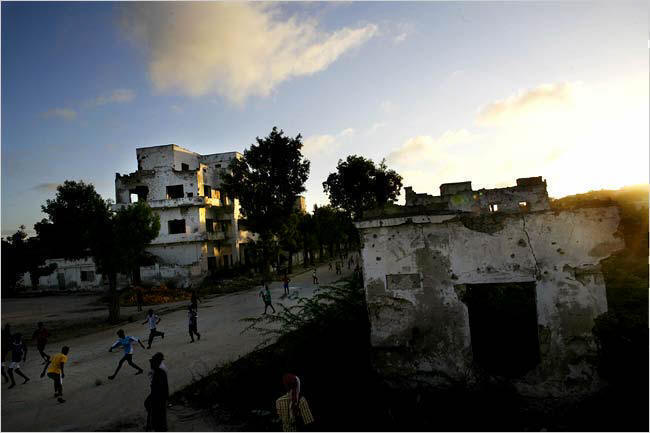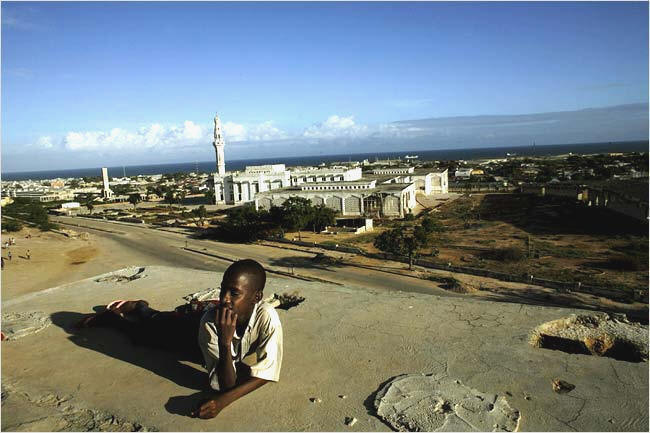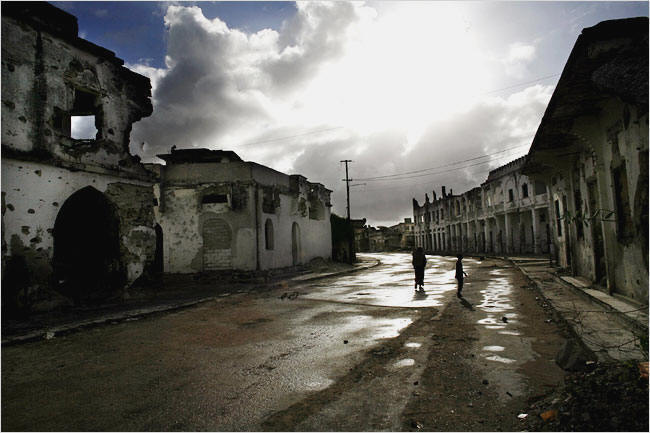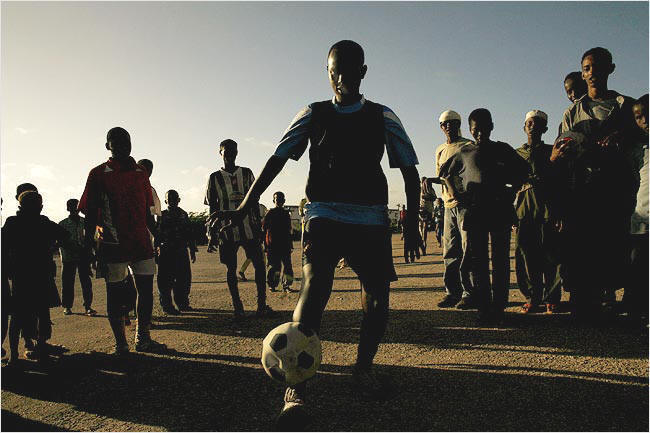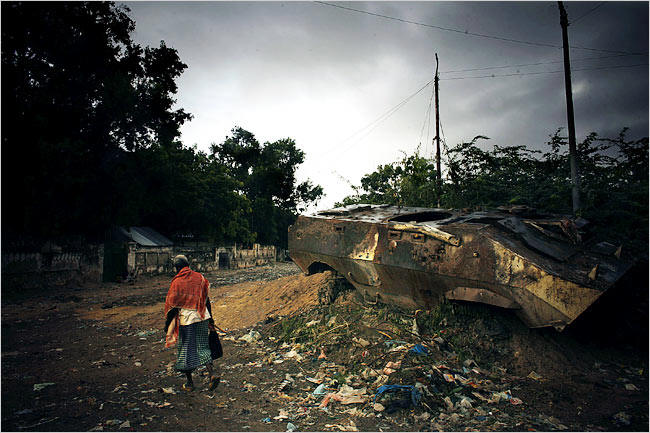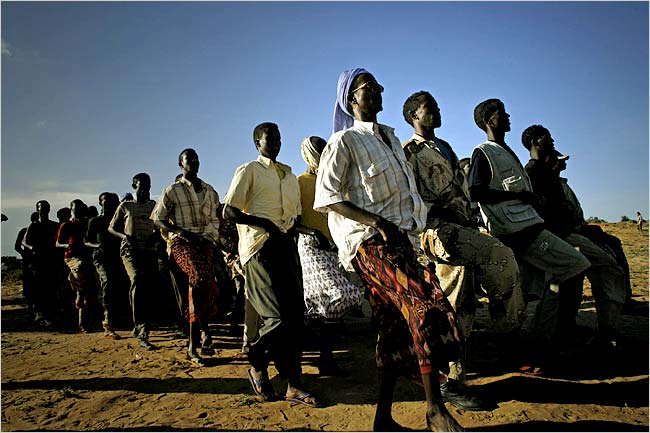| Zooming in Mogadishu |
|
Islamists Calm Mogadishu
SEPTEMBER 24, 2006
The former Mogadishu municipality buildings built by Italy in the late 1920's are now destroyed and riddled with bullet holes.
Mogadishu’s 15 years of anarchy took a heavy toll on the city’s former business district, but a mini building boom is now under way.
Islamists Calm Somali Capital With Restraint
JEFFREY GETTLEMAN The New York Times September 24, 2006
MOGADISHU, Somalia, Sept. 23 — As the sun begins to sink over this broken city, work crews swing their axes over their shoulders and head home.
Young couples take to the waterfront, mingling openly in the salty breeze. Thousands of children flock to soccer fields in the city center, with a backdrop of beautifully crumbled ruins from battles now over.
It is hard to imagine that this is Mogadishu, the same Mogadishu of “Black Hawk Down,” and clan against clan and 15 years of anarchy. But over the past three months, the Islamists in control here have defied international expectations — in many ways. Not only have they pacified one of the most dangerous cities in the world, they also seem to have moderated their message.
Instead of acting like the Taliban and ruthlessly imposing a harsh religious orthodoxy, as many feared, the Islamists seem to be trying to increase public support by softening their views, at least officially, delivering social services and pushing for democratic elections.
Islamic leaders are operating almost in campaign mode, organizing street cleanups, visiting hospitals, overseeing a mini building boom and recruiting elderly policemen to don faded uniforms they have not worn for years and return to work. Beyond that, they sent a letter this week to the United Nations Security Council pledging to support democratic rule.
Maybe this is just smooth talk. Or premature signs that could prove misleading. Hard-core elements still operate here, including militiamen who drive around with black scarves and black flags and shoot people for watching Hollywood movies. Young men like them were believed to have killed an Italian nun at a Mogadishu hospital last Sunday, apparently in retaliation for Pope Benedict XVI’s remarks on Islam.
But the Islamist leaders say they are rogue elements who will be punished, and they have reopened some movie theaters and issued decrees emphasizing tolerance. Whether they live up to those promises seems to hinge on whether they can, or even want to, rein in the militant groups that helped propel them to power.
“The world was so quick to label us,” said Ibrahim Hassan Addou, the foreign minister for the Islamic administration in Mogadishu. “All we are asking is to be judged on our deeds.”
The United States continues to assert that the Islamists are sheltering Al Qaeda terrorists. The suicide attack against the United Nations -backed transitional government in Baidoa on Monday only reinforced that suspicion, though the Islamists deny any involvement.
But the darkest fears of a draconian Islam on Africa’s east coast have not come true, at least not yet. Boys are allowed to play soccer, and girls are allowed to go to school, despite rumors to the contrary. And businesses are not forced to close during prayer time, as has been widely reported outside of Mogadishu.
In fact, people were selling bread, biscuits and watermelon right in front of the Islamic forces’ headquarters during the noon prayer earlier this week. The teenage militia members standing guard regressed to the boys that they were, giggling over giant slices of watermelon and spitting seeds at each other, the juice running down their chins and dripping onto their guns.
“Nobody knows where we’re headed,” said Ahmed Mohammed Ali, chairman of a Mogadishu human rights organization. But, he added, the Islamists “pacified this place and brought the clans together.”
“Whatever you think about them,” he said, “you can’t overlook that.”
There is a famous story that says much about Somalia. It sounds like a fable, but according to several Somali businessmen, it is sad but true.
There were two close friends who owned a fishery north of Mogadishu. They were like brothers and vowed that if anything ever happened to either of them, the other would take care of the his family. They were from the same clan but from different branches of it, the Saad and the Saleeban. One day the Saad man was caught in a cross-fire and killed accidentally by a Saleeban militia. Within hours, the Saad took their revenge and without consulting the dead man’s family shot to death his best friend.
“Anarchy is bad, man,” said Adam Daley, a Somali-American businessman living in Mogadishu. “Can you imagine New York City without any police? Or light?”
This is how Mogadishu, the capital of Somalia, was since 1991, when clan-based warlords brought down the central government. United States marines and United Nations peacekeepers tried to restore order, but the people rallied behind the warlords and helped drive the foreigners out.
The fighting razed the city’s famed Italian architecture and left a leadership vacuum. Gradually, clan elders set up small courts to resolve disputes, using Islamic law to guide them.
Before the war, that might have seemed strange. Somalia used to be a secular place, where women wore skirts and men drank beer.
But in the period of anarchy, the culture changed. After Western aid organizations pulled out, Arab charities rushed in, bringing Koranic schools and more religion.
Militant Islamic groups opened camps in Somalia’s deserts. According to terrorism analysts, American intelligence officers began hiring warlords to kidnap terrorism suspects and take them to bases outside Somalia. Often the suspects were innocent imams or businessmen who were soon set free.
By 2004, the Islamist groups teamed up with clan courts and businessmen to protect themselves from the warlords, calling their alliance the Union for Islamic Courts.
Last winter, the warlords announced that they, too, had formed an alliance, the Alliance for the Restoration of Peace and Counterterrorism. It was a well-known fact, buttressed by the annoying aerial drone that buzzed over Mogadishu at night, that they had American support.
That played straight into the hands of the Islamists, who quickly built an army called the Shabab, or youth, made up of young, devout fighters, to overthrow the warlords. The Shabab wore green skull caps and little beards. They did not smoke cigarettes or chew qat, the popular narcotic leaf that had spurred so much of Mogadishu’s madness.
People were impressed.
“Every day at noon women were driving to the front lines to bring these guys food,” recalled Ali Iman Sharmarke, one of the founders of the HornAfrik television and radio station.
The warlords were steadily pushed back and soon could not trust anyone, including phone operators, whom they suspected of tapping their calls.
“We had no communication or leadership,” said Col. Ali Warsame, whose warlord commander ended up fleeing Mogadishu on the back of a donkey and wearing a veil. By the first week of June, all the warlords had been defeated.
The courts’ first move was a thank you to their patrons. Within weeks, Mogadishu’s port and airport, which had been essentially closed for more than a decade, were open for business.
The courts then took many of the warlords’ militiamen to an old army base outside the city.
There, under a searing sun, 700 young men march in circles, chanting, “God is great!” and doing a funny elbow-swinging goose step.
“It’s Russian,” Col. Muhidin Haji, the camp commander, explained.
The courts are now focusing on civil administration, with committees on sanitation, reconstruction, education and justice. Investment money is already flowing back in. The streets around Mogadishu’s main market are clogged with trucks hauling logs and cement. To oversee all this, the Islamists have appointed university professors, including many educated abroad, to crucial posts.
The Islamists are meeting with leaders from the transitional government based in Baidoa, 150 miles inland, to discuss sharing power. Despite being recognized by the United Nations, the transitional government has very little support among Somalis.
Under a United Nations-backed framework, Somalia is supposed to have elections by 2009. The Islamists say the sooner the better. They know they are the most popular force in the country.
One morning this week, hundreds of men volunteered for an Islamist-organized clean up. With the clap of his hands, the work leader sent them plunging into overgrown thickets to clear brush. “It’s an exchange,” said Abdul Aziz Issah, one of the workers. “They brought us peace, we give them work.”
There is so much of it to do. Huge swaths of the capital have been reduced to ruins, with an arch left here, half a crumbling wall left there. In many places, Mogadishu looks like an ancient city that has been deserted for centuries, just riddled with holes.
Photos : Jehad Nga for The new York Times
Children flock to soccer fields in the city center as Thursdays mark the start of the Islamic weekend.
A man walks past one of the many destroyed U.N. vehicles that litter the streets of Mogadishu, remnants from the last U.N. presence in the city during the early 1990's.
Military recruits jog in formation during an exercise. Former fighters allied to the warlords who previously ran Mogadishu now train at a military camp run by the Islamists.
|
